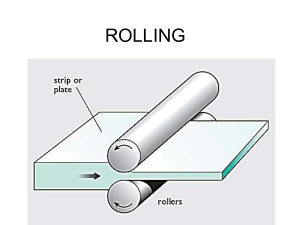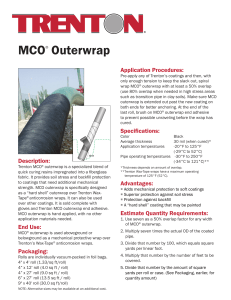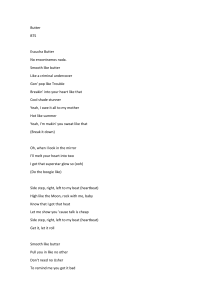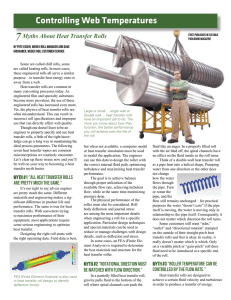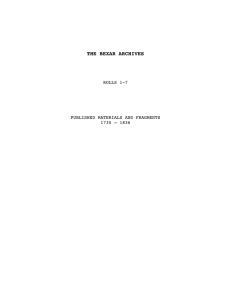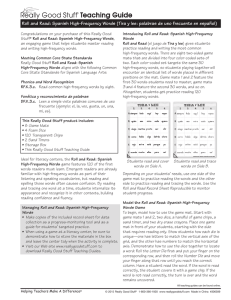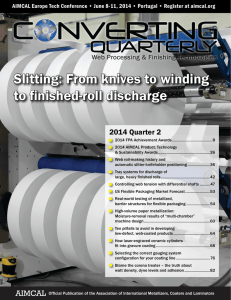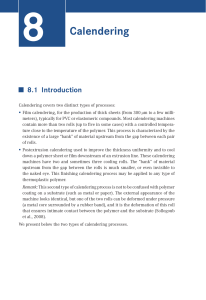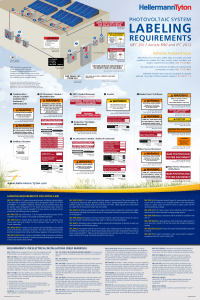Maintenance and Storage of Heat Transfer Rolls
Anuncio
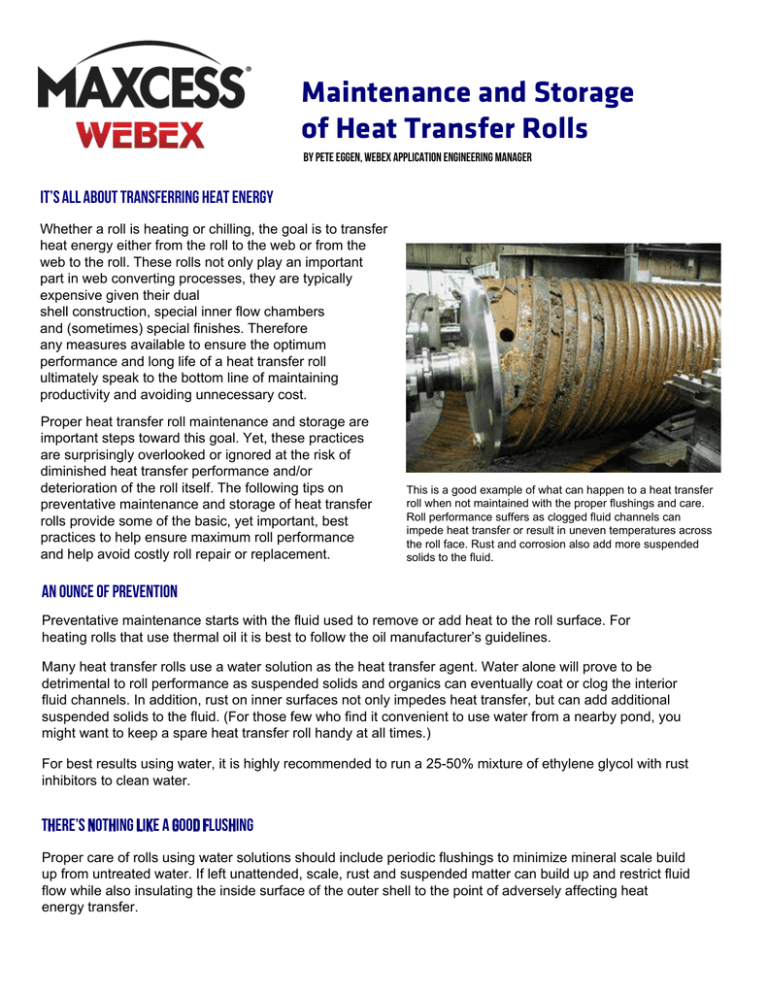
Maintenance and Storage of Heat Transfer Rolls By Pete Eggen, Webex a li ation engineering anager t s ll bout rans erring eat nerg Whether a roll is heating or chilling, the goal is to transfer heat energy either from the roll to the web or from the web to the roll. These rolls not only play an important part in web converting processes, they are typically expensive given their dual shell construction, special inner flow chambers and (sometimes) special finishes. Therefore any measures available to ensure the optimum performance and long life of a heat transfer roll ultimately speak to the bottom line of maintaining productivity and avoiding unnecessary cost. Proper heat transfer roll maintenance and storage are important steps toward this goal. Yet, these practices are surprisingly overlooked or ignored at the risk of diminished heat transfer performance and/or deterioration of the roll itself. The following tips on preventative maintenance and storage of heat transfer rolls provide some of the basic, yet important, best practices to help ensure maximum roll performance and help avoid costly roll repair or replacement. This is a good example of what can happen to a heat transfer roll when not maintained with the proper flushings and care. Roll performance suffers as clogged fluid channels can impede heat transfer or result in uneven temperatures across the roll face. Rust and corrosion also add more suspended solids to the fluid. n un e o re ention Preventative maintenance starts with the fluid used to remove or add heat to the roll surface. For heating rolls that use thermal oil it is best to follow the oil manufacturer’s guidelines. Many heat transfer rolls use a water solution as the heat transfer agent. Water alone will prove to be detrimental to roll performance as suspended solids and organics can eventually coat or clog the interior fluid channels. In addition, rust on inner surfaces not only impedes heat transfer, but can add additional suspended solids to the fluid. (For those few who find it convenient to use water from a nearby pond, you might want to keep a spare heat transfer roll handy at all times.) For best results using water, it is highly recommended to run a 25-50% mixture of ethylene glycol with rust inhibitors to clean water. There’s othing i e a Good lushing Proper care of rolls using water solutions should include periodic flushings to minimize mineral scale build up from untreated water. If left unattended, scale, rust and suspended matter can build up and restrict fluid flow while also insulating the inside surface of the outer shell to the point of adversely affecting heat energy transfer. The condition of the water or fluid typically dictates the roll flushing schedule. As a rule of thumb, in areas that have hard water, water with high acidity or water with high solids content, it is recommended that rolls be cleaned once every six months. Installations that employ a closed-loop system, and/or use a 50-50 water/ethylene glycol mixture should be cleaned every 12-16 months. Allow up to a day for recirculating flushings to achieve maximum effect. After a few flushings operators and maintenance techs will come to know the water condition being discharged and can subsequently determine appropriate flushing schedules for each heat transfer roll. Prior to storage, fill a previously drained heat Water quality varies from community to community, even “city transfer roll as full as possible with a rust water” can be hard. The only way to know your plant’s water inhibitor solution or biodegradable antifreeze, not water. quality is have it tested by a commercial or residential water treatment professional. Push come to shove, city water is typically better than well water and well water is almost always better than pond water. Most flushings employ a pump-through method where the cleaning solution is prepared in a drum and run through the roll by means of a recirculating pump. It is highly recommended to follow the solution manufacturer’s directions carefully. If more than one heat transfer roll is to be cleaned at the same time, do not pump the same solution through more than one roll unless a filter is used between flushings to screen out any solids or scale. Acid solutions are commonly used as effective flushing agents for heat transfer rolls. As most heat transfer rolls are manufactured of carbon steel, acid flushings will not damage internal parts or surfaces. Manufacturers of acid solutions include Ohio Valley Chemical Corporation and Chemetall Americas. DON'T FORGET RUST INHIBITORS Acid solutions are commonly used as effective flushing agents for heat transfer rolls. These solutions often include rust inhibitors. As most heat transfer rolls are manufactured of carbon steel, acid flushings will not damage internal parts or surfaces. Manufacturers of acid solutions include Ohio Valley Chemical Corporation and Chemetall Americas. Your heat transfer roll provider may recommend other sources, too. Storage Guidelines When a heat transfer roll is put in storage, certain precautions should be taken. Internal and external corrosion is the enemy of heat transfer rolls in storage. If a heat transfer roll is stored with fluid still inside and vented to the open air, corrosion will develop on interior surfaces. Unfortunately, it is very difficult to determine whether all fluid is removed from a heat transfer roll and the inside is dry. Even if the inside were dry, high-humidity environments can still lead to corrosion. Corrosion forms inside where water sits. It ultimately settles to the bottom where it forms a deposit that can affect heat transfer and roll balance. Acid cleaning after storage may or may not be able to remove this deposit. In a worst case scenario, a company can end up with a ruined roll. o safeguard the exterior surfaces of the heat transfer roll, coating it with rust-preventative oil and a rustpreventative wrap is a good practice. Alternatively, there are protective films such as VCI (vapor corrosion inhibitor) packaging film that can be used in place of oil coatings. To avoid internal and external corrosion problems, here are six tips for effective heat transfer roll storage: - Before storing the roll, drain any fluid from the roll. - Fill the roll as full as possible with a rust inhibitor solution or biodegradable antifreeze. Do not use water. Water does not have the ability to prevent corrosion that a rust inhibitor solution or biodegradable antifreeze has. - Cap off the ends to retain the fluid and eliminate air. Most ends of rolls are threaded, so pipe plugs are often Once the roll is filled with a rust inhibitor solution or used as caps. biodegradable antifreeze, plug the roll for storage. - Rotate the roll to coat all internal surfaces. - Use proper corrosion protection on the roll exterior, appropriate for the type and length of storage used. Be advised that even chrome plated surfaces may require some level of corrosion protection depending on conditions. - Store the roll in a dry, safe location with reasonably consistent temperature. While proper maintenance and storage can prolong heat transfer roll performance, sometimes a roll simply needs to be serviced by the manufacturer. Many heat transfer roll manufacturers will perform roll flushings. Roll refurbishing may also include surface regrinding, refinishing and/or replating. Journals may need to be reworked. Rolls can also be opened up to determine inside issues. In many cases, it is more practical to replace the roll than it is to refurbish one with highly corroded and deteriorated insides. Before storing the roll, use proper corrosion protection on the roll exterior, such as the wrap shown here, appropriate for the type and length of storage chosen. Conclusion he dangers of corrosion which include improper heat transfer and improper roll balance from a corrosion deposit can be avoided with a little preventative maintenance and proper storage. Properly cared for heat transfer rolls will offer greater performance over the long haul. he best results come from best practices. Proper fluid, proper cleaning flushing, proper storage inside and out ... all help lead to the effective exchange of heat energy and better web heating or cooling. ou ll also avoid unwanted downtime and lost productivity when the roll no longer performs to expectations, not to mention the cost of refurbishing or replacing the entire roll. With these practices, you can ust eep rolling about the author Pete Eggen, Application Engineering Manager at Webex, has more than 26 years experience within the converting industry in process analysis, product design, development and applications engineering for precision rolls, from Idler Rolls and Vacuum Rolls to Heat and Chill Rolls. WebexAd9.qxp_Layout 1 11/6/14 11:12 AM Page 1 Engineered to your specifications. Manufactured to exceed expectations. Form and function are critical to the performance of Heat Transfer Rolls. That's why Webex Engineers design each roll to precise specifications using advanced computer analysis and field experience before fabrication ever begins. Each roll takes shape in a facility dedicated to that particular style of roll, where production teams have the experience and resources to provide consistent, accurate and reliable results. We’ve been perfecting this process for more than 40 years. As a brand of Maxcess, we now have more capability to support our customers and share our experience globally. Call 800.569.1286 or +1.920.729.6666 or visit www.webexinc.com/temperaturecontrol to see why leaders of industry trust Webex. FOX, Magnat Fairview and PFE are now Webex. Learn more at www.webexinc.com/strongertogether.
